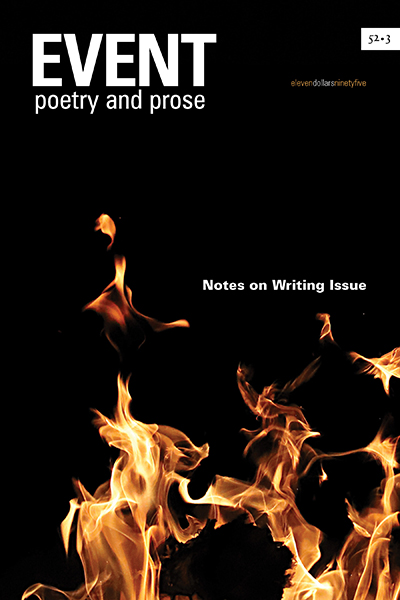John Wall Barger Reviews New Poetry Collections from Julie Joosten and Sadiqa de Meijer for EVENT 49/2

John Wall Barger Reviews:
Julie Joosten, Nought, Book*hug, 2020
Sadiqa de Meijer, The Outer Wards, Signal Editions, 2020
Every book of poetry teaches us how to read it: as political, confessional, philosophical, playful and so on. Like a generous guide, the book points out favourite haunts and secret passageways. It lets us know if, figuratively speaking, we’re walking along dangerous cliffs, or in open fields. Good poetry goes further, often offering something that’s palpably at stake, a risk or an edge, creating productive tension. Such poems occur at a fork in the road, an uncertain moment of decision where something can be lost, such as in Linda Pastan’s ‘Ethics’: ‘if there were a fire in a museum/which would you save, a Rembrandt painting/or an old woman who hadn’t many/years left anyhow?’ James Wright’s ‘Saint Judas’—which begins, ‘When I went out to kill myself, I caught/A pack of hoodlums beating up a man’—is less clear about what can be lost, but still hooks the reader with a sense of dramatic consequence. Sometimes, as with the dazzling elliptical poems of Rae Armantrout, the tension and purpose are undeniable, but tricky to articulate.
Julie Joosten’s Nought is a difficult book that also, satisfyingly, lets the reader know what’s at stake. The book is a long (149-page) series of untitled poems within titled sections, largely concerned with consciousness, the mind and language. In the last section, an essay called ‘An Opening,’ Joosten provides a generous skeleton key to help us unlock her complex, multilayered text. She explains that she suffered brain trauma twice, the second time while writing Nought: ‘I could once more experience my brain and body, psyche and soma, unravelling and reforming, foreign and familiar. I relearned the processes of perceiving through the very strange porosity of a boundaryless perception of perceiving.’ Thus Nought charts the poet’s rehabilitation: the ‘unravelling and reforming’ of her consciousness. ‘Recovering from a brain injury,’ she writes, ‘sometimes feels like an adult experience of infancy: the first intimations of consciousness, amazement at sensory experience, learning to walk and move…’ What’s at risk is Joosten’s mind itself.
Nought’s ‘recovering’ traces a path from figurative to literal, from solipsistic mental states to ‘learning to walk and move’ among the physical world of friends and (we are told at the end of ‘An Opening’) a baby boy. That said, Nought’s primary ecosystem is figurative. In Joosten’s poems, a literal-seeming image is often subsumed by figurative language (‘My womb remains thought, current,/breeze under apple trees, my womb/remains the temperature for breathing/with the tide’). Joosten’s voice recollects Lisa Robertson’s: a sharply witty inner monologue or conversation with various psychic selves; and restless play with genre and form. Thankfully, Joosten leaves clues like breadcrumbs to help us traverse this figurative landscape. The end of ‘Necklace,’ the second section, is an Ars Poetica:
body’s ecstasy, dog’s daydream,
pleasure in ambiguity, respect
and care and peace and bliss, to inhabit
a continuum of (un)consciousness,
plenitude in evanescence, nest
of generous attention, beautiful
bewilderment, memory-keeping,
barely discernible blood song, breath flight,
beadwork of cells dividing in the night,
roomy intimacy, to be love, storm
shelter, to float without water, milkweed,
love amplifying love, becoming’s form,
sensation of life, gratitude’s lungs, breath
of praise, knowing’s dissolve, being understood
Nought itself is a ‘nest/of generous attention,’ ‘intimacy’ and ‘breath’ enacting the ‘gratitude’ and ‘blood song’ of the poet’s psyche. Such generosity and clarity steer these cerebral poems from solipsism.
Loosely, Nought is an allegory of rehabilitation, a poetics of brain trauma, tracing the positive steps back from a certain abyss. One senses the speaker’s natural fear, the challenges of ‘learning to walk and move’ back into the world: ‘I touch my fears, hush/my fears.//Will we allow as much?’ And from fear the speaker inches toward compassion: ‘beloveds, here is a child to honour/your mouths on these pages—’
‘Love Poem,’ a long poem to a friend, is suddenly, deliciously literal: ‘And I was careful not to touch you.//And each evening, the dogs and I wait for your return, perking our/ears at every sound that might be the latch of your arrival—’ After so much self-referential meta-language, such concrete imagery is a welcome counterpoint.
At the centre of Sadiqa de Meijer’s The Outer Wards is a powerful bond between mother and daughter. The lyric poems in the first half of the book are punctuated with intense moments of love and gratitude for the infant child: at a grocery store (‘I’ve never/elated anyone//as much as her inside our headlong now’); in a park (‘The closest I’ve come/to holding the chirps and warbles of her voice/was when she sang to me through a pool noodle,/and each word trilled in my hands./I wanted it to last forever’); and at home. Later, the book takes a heartbreaking turn as the mother falls ill and must watch her daughter suffer without her: ‘No one/takes measure of her shoes, toes crowding/like tree roots; her socks have been damp for days.’ In The Outer Wards, the life of a mother is literally under threat.
I move differently now, which means I have altered
my temporal experience. My tread is gradual, and my mind
is an umbrella. I know the minutes as the lichens
on the breakwater know them. It is like holding my usual breath
for a few years, and finding that another part
of me is breathing.
Here the mother remembers not being a mother. We all know this sense, however fleeting, of stepping outside of a cherished role. And since we relate to this mother/daughter bond (‘I wanted it to last forever’), we know the cost of losing it. There’s a razor alertness to these lines, a tracing of the breath in an existential instant. Being a mother ‘is like holding my usual breath/for a few years,’ but the same human is under there, waiting, witnessing. Similarly, the end of ‘The Imaging Department’ describes the speaker’s powerful first vision of her child on an ultrasound machine:
and then I heard them say, That’s it. When I turned
I saw it pulse in dark and grainy currents
on a screen. Nothing like a valentine
or dove—uncatalogued
marine, perhaps, and blunderous,
and fugitive.
The speaker is not in the mother role, exactly, at this moment. Her observation of the fetus (‘it’) as ‘blunderous,/and fugitive’ is as coldly brilliant and ruthless as any by Sylvia Plath. The speaker is in a nebulous, arch-human border between roles, recognizing that with this ‘pulse in dark and grainy currents’ comes a vital change that will jeopardize her old sense of self.
But elsewhere what’s at stake is not always discernible. Since The Outer Wards is not overly abstract or experimental, but concerned with real-world issues like parenthood, sickness and identity, the book seems to be teaching us to read it with emotion and not just intellect. While there are some extremely lucid images (‘When Sei practices marimba with the window open, we sit/on a stump in her yard to listen’), Meijer sometimes leaves out vital context, making it tricky for us to feel for the people involved. The speaker walks through ‘Skeleton Park,’ but doesn’t say where that is (Kingston, Ontario, Canada); she’s a ‘Sick Mother,’ but doesn’t say what illness she has; she ‘studied medicine,’ but doesn’t say what her job is. ‘Red-Eye,’ which describes a plane trip, begins, ‘Dear country, did you wait for me?’ The speaker seems to be returning to the old country (‘Here is the clay/that holds the brittle calcium of them who made me’), but we never learn which country is being left and which is being apostrophized.
There are remarkable moments in The Outer Wards. The overarching image is that of a mother haunted by love for her daughter, willing to cross any landscape to retrieve her: ‘I’d fall so vaporously/to the summit park, ground stowed with bones,/rope climber, scarred maple housing a screech owl, and the/star/of tarmac streets that fractures out from there, I’d hurry/along the houses, seeking her…’ This vision—like the lactating mother in Cormac McCarthy’s Outer Dark, wandering the gothic forests of Appalachia in search of her missing child—endures long after the book is put down.
—John Wall Barger













